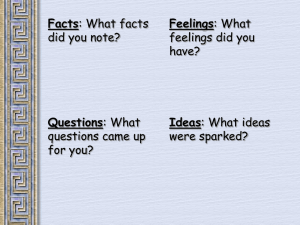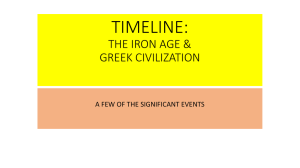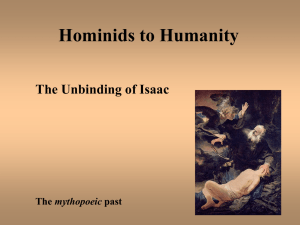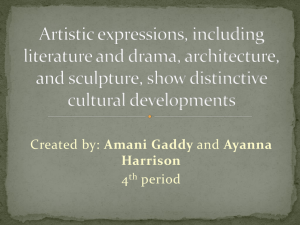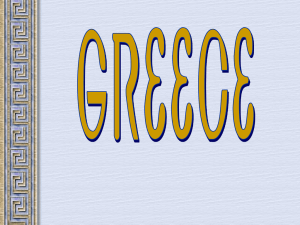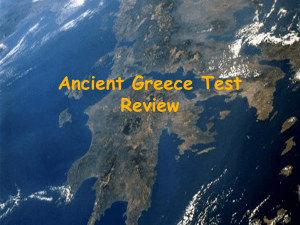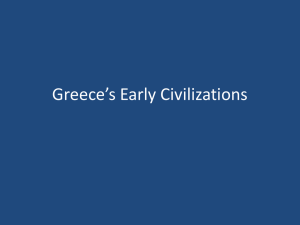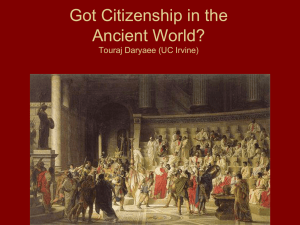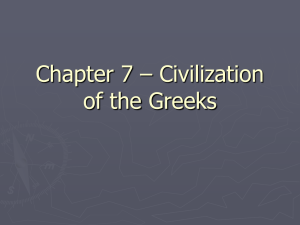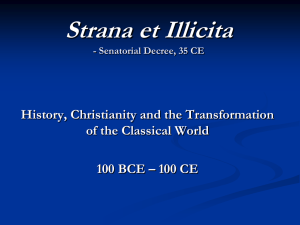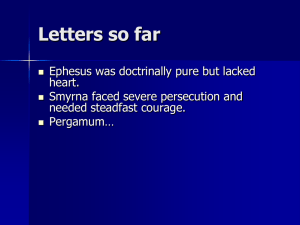Chapter 4 – Civilization of the Greeks
advertisement
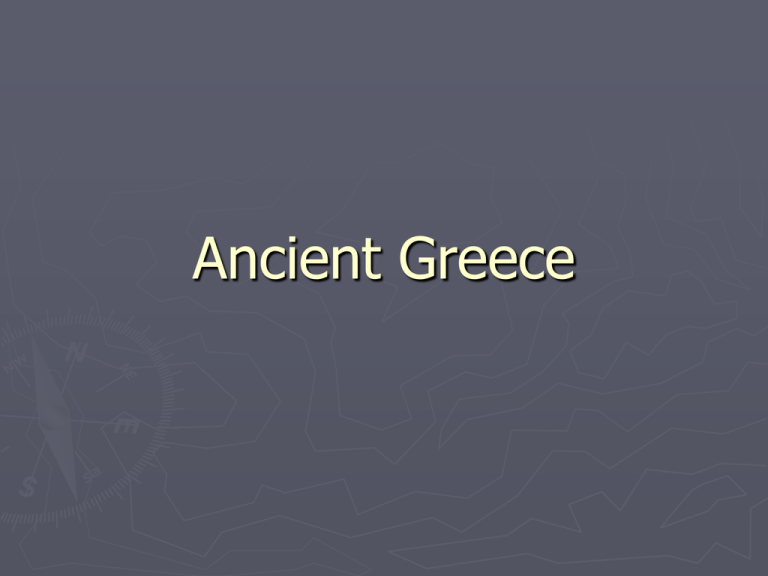
Ancient Greece Major Topics ► Minoans to Mycenaeans: Women to Men? ► Greek polis: Democratic? ► Archaic and Classical Greece ► Greeks and Persians ► Peloponnesian War ► Alexander the Great Geography and Greek History Mountains – kept each community separated from each other – natural borders Seacoast – lots of inlets and bays – became a seafaring people Minoan Crete ► ► ► ► ► ► 2800 BCE - just off Greek mainland Prosperous culture and sea empire Traveled and traded with Egyptians Reached its height in 2000-1450 BCE - Knossos Sudden collapse in 1450 BCE – invasion of Mycenaeans Bronze Age Crete website Crete Minoan Fresco, Town Minoan Fresco Minoan Fresco, Saffron Gatherer Minoan Fresco Minoan Fresco, “Ladies in Blue” Minoan Fresco Minoan Snake Goddess Role of women in Minoan society? More depictions of women in public and religious ritual roles than later Greek societies Women goddesses Not usually depicted in maternal roles Snake Goddess research site link Mycenaeans ► ► ► ► ► ► 1600-1100 BCE (height of culture) Indo-European group Powerful monarchs Warrior people Built extensive commercial network Epics by Homer about the Mycenaeans: The Iliad & The Odyssey… King Agamemnon conquered Troy in 1250 BCE The term Mycenaean is derived from Mycenae, a remarkable fortified site excavated by the amateur German archaeologist Heinrich Schliemann starting in 1870. Mycenae was one center in a Mycenaean Greek civilization that flourished between 1600 and 1100 B.C.E. The Mycenaean Greeks were part of the Indo-European family of peoples who spread from their original location into southern and have become shrouded in mystery. The Slaying of Hector This scene, painted on a Corinthian Greek vase, depicts the final battle between Achilles and the Trojan hero Hector, as recounted in Homer’s Iliad. The Iliad is Homer’s epic masterpiece and was used by later Greeks to teach the aristocratic values of courage and honor. © AAAC/Topham/The Image Works The Greek City States ► 750 – 500 BCE city-states began to emerge ► Known as POLIS ► At center of city-state or polis was the AGORA or marketplace where the lower courts were held Polis community had 3 parts: ► ► 1. citizens with rights (adult males) 2. citizens with no rights (women & children) 3. non-citizens (slaves and resident aliens) Greeks = center of world democracy? Between 750 and 500 B.C.E., Greek civilization witnessed the emergence of the city-state as the central institution in Greek life and the Greeks’ colonization of the Mediterranean and Black Seas. Classical Greece lasted from about 500 to 338 B.C.E. and encompassed the high points of Greek civilization in arts, science, philosophy, and politics, as well as the Persian Wars and the Peloponnesian War. New Military System ► Hoplite Infantry – heavily armed with bronze or leather helmets, breastplates, shin guards, shields and swords – only those that could afford the weapons could be a part of this militia group ► Phalanx – Formations that the hoplite infantry used to advance against enemy – rectangular shape Archaic Greece, 750 – 550 BCE ► Great number of Greeks left the colonies: 1. growing gulf between rich and poor 2. overpopulation 3. development of trade (increased industry) ► Tyrants rose as rulers (not Evil) – rulers not subject to laws … young aristocrats (See page 160 for definition of tyrant) ► Tyrant Pisistrates Reduced taxes/free loans Offered people chance at prosperity (olives & industry) Aristocracy to Democracy ► 527 BCE Pisistrates died … Hippias When brother was murdered turned against people … Cleisthenes overthrew Hippias with help from aristocracy and crowds … (510 BCE) ► Aysagarus joined with Spartans (rivals of Athenians) to exile Cleisthenes and aristocracy … ruled from Acropolis ► 508 BCE ******* Revolution !!!!!!! ► “Bring Cleisthenes back” …. Democracy was born! Classical Greece, 500-323 BCE ► Age of Pericles – Height of Athenian Greek Power ► Assembly passed all laws and made final decisions on war and foreign policy Made lower-class citizens eligible for public office Olympic games Became leading center of Greek culture – Drama/theatre Built Parthenon on Athenian Acropolis Classical idea of art – statues of gods Philosophy (“love of wisdom”) Sophists – scholarly realists Rhetoric – debate Socratic Method – question and answer techniques Herodotus – early Greek historian and master story teller Advancements were a threat to Sparta The Parthenon GoogleMap Parthenon Frieze Pics Interactive Frieze The arts in Classical Greece were designed to express the eternal ideals of reason, moderation, symmetry, balance, and harmony. In architecture, the most important form was the temple, and the classic example of this kind of architecture is the Parthenon, built between 447 and 432 B.C.E. Located on the Acropolis in Athens, the Parthenon was dedicated to Athena, the patron goddess of the city, but it also served as a shining example of the power and wealth of the Athenian empire. © Photodisc (Adam Crowley)/GettyImages Statue of Athena, Parthenon Replica statue of Athena in Nashville’s Replica Parthenon Greek Democracy Greek polis – many city-states developed governing structures that included citizens to a certain extent – democracy one form ► Spartans included adult males, but had hereditary kings too ► Draco’s Athenian legal code, 621 BCE, law belongs to all citizens – set precedent towards inclusion ► Solon, 590s BCE, limited power of Athenian aristocracy ► 508 BCE, Athenian democracy formed – all male citizens voted on laws ► Inclusive (all adult males) and… ► Exclusive (women, slaves, and males under 18) ► Greek Religion and Mythology ► World and human events ordered by pantheon of gods and goddesses ► Gods were anthropomorphic (human-like) with diff. personalities and powers – active in human lives ► Rituals, rites, sacrifices to gods at temples throughout Greece (ex. was Parthenon, temple of Athena, in Athens) ► Greeks could divine the future through oracles (most important oracle was at Delphi to Apollo) ► List of major gods and goddesses (with statues) Greek Drama ► Plays were funded by the polis (city) ► Usually performed only once at religious festival for Dionysus (God of wine, pleasure, theater) ► Performed at drama competition: 1st, 2nd, and 3rd place votes from spectators ► Public outdoor theaters ► 3 male actors played all parts, along with chorus ► Tragedies were about mythic events, comedies about current events and figures ► Theater Pics ► Structure of Theater Greek Playwrights ► Aeschylus (525-456 BCE): conflict between human desire, justice, reason ► Sophocles (496-406 BCE): Oedipus plays, problems of human pride ► Euripides (480-406 BCE): conflict of emotion and reason ► Aristophanes (445-386 BCE): comedies about public issues Dionysus God of Wine, Festivals, Theater Website on Dionysus: images, cult of, mythology, history Sparta ► Grew out of Mycenaean empire – warriors, “descendants of Zeus” ► ► Oligarchy – not a democracy 2 kings over military Gerousia – council of elders (shared power with kings) Apella – general assembly of all male citizens ► Very closed/strict society ► 500 BCE Sparta used military might to gain control of Peloponnesus (dominates Peloponnesian League) ► ► Greek Conflict with Persia Ionian Revolt, 499 BCE – rejected Persian rule ► Darius defeated at Marathon (492 BCE) ► Xerxes vowed to finish the job of his father and defeat Greece – invaded with huge army (481 BCE) ► Sparta in charge of “land war” – King Leonidas Athens in charge of “sea war” – Themistocles Sparta’s objective was to hold off the Persian army (Thermopylae – mountain pass in Greece) until the naval fleet was in place at Salamis, and this would then force the Persians to make a naval battle – but defeated Persians there (and at Salamis) ► ► Stalemate between Greeks and Persians – Peace treaty (Callias), 448 BCE Greek city-states went back to fighting eachother Peloponnesian War and Decline of Greek States ► After the wars with Persia, for about 40 years, Greece was a divided country Athens v. Sparta 431 BCE War broke out … Athens = Defensive – stay behind walls of Athens Sparta = Offensive 405 BCE Athens naval fleet was defeated at Aegospotami Athens surrendered to Sparta ► All of Greece was weakened by the wars ► ► ► ► ► ► …. (Aristophanes’ play Lysistrata is set during the Peloponnesian War after Athens’ naval defeat) Various major Greek city-states Leaders: Athens & Sparta Peloponnesian War – Alliances between major powers and other city-states Rise of Macedonia and Alexander the Great (Also see reading in textbook under Chapter 6, pages 150 – 151) 359 BCE – Phillip of Macedonia Built a country on diplomacy and strength ► ► ► ► New military and technology Phalanx Sarisa (pike) Crossbows Catapults 338 BCE - Victory over Athens and Thebes (battle of Coronea) Created Corinthian League Alexander the Great ► ► Became Macedonian warrior at 14 years old Served as a general at 18 years old ► Father Phillip was murdered; Alexander stepped into his place ► ► Took over for his father at 20 years of age Continued use of military/technology ► 334 BCE – Battle against Persia (Also see textbook pages 150-151) Alexander the Great This marble head of Alexander the Great was made in the second or first century B.C.E. The long hair and tilt of his head reflect the description of Alexander in the literary sources of the time. Alexander claimed to be descended from Heracles, a Greek hero worshiped as a god, and when he proclaimed himself pharaoh of Egypt, he gained recognition as a living deity. It is reported that one statue, now lost, showed Alexander gazing at Zeus. At the base of the statue were the words ‘‘I place the earth under my sway; you, O Zeus, keep Olympus.’’ © British Museum, London/HIP/Art Resource, NY In just twelve years, Alexander the Great conquered vast territories. Dominating lands from west of the Nile to east of the Indus, he brought the Persian Empire, Egypt, and much of the Middle East under his control. TYRE (off shore island) - key strategic location ► causeway – land bridge to island ► siege towers A brief video: http://www.youtube.com/watch?v=h2y4_ixurE8 (link to video on Alexander and Tyre) (right click to open hyperlink) 332 BCE – Battle of Issus – Meets Darius III and defeated him 332 BCE (late) – Syria, Palestine and Egypt were under his control EGYPT 331 BCE No bloodshed Proclaimed himself the “liberator” They proclaimed him “son of Amon” and Pharaoh Alexandria was built (center of culture/science/learning) HELLENISM – “to make Greek” – Greek way of Life was spread throughout Mediterranean, North Africa, Middle East, as far as India Pergamum & Egypt ► Athen’s greatness started to dwindle in the face of the new Alexandrian cities ► Alexander’s Greatest Cities – Alexandria, Egypt and Pergamum, Anatolia (modern-day Turkey) great terraces huge theater temples at high places public buildings/gymnasiums/agora Trajan Temple at Pergamum Temple of Sarapus Pergamum Theatre at Pergamum Alexander’s Demise ► 327 BCE – Entered India – furthest extent of empire Alexander’s army and empire influenced Indians – creation of Mauryan Empire (from India Chapter) ► ► ► ► ► Complaining among Troops Turned around to go Home …. 323 BCE – Alexander ill and died (32 years old) Leaders began to fight for Empire Raised a common problem of empire, rule, and power: how to maintain empire after strong ruler’s death Hellenistic Kingdoms ► Parts of Alexander’s former empire – even after his death, “Greek” rule & Hellenism had a lasting effect on former empire ► Split into separate kingdoms: 1. Macedonia – Antigonid Dynasty (most powerful) 2. Syria and East – Seleucids (largest) 3. West and Asia Minor – Pergamum 4. Egypt – Ptolemy (wealthiest and most influential) good coast/harbor 1st lighthouse constructed (300-400 feet tall) The World of the Hellenistic Kingdoms Sketch of Lighthouse constructed at Egypt (Thiersch) Greek Influence in Mediterranean and Middle East Economic/Social/Trade ► ► ► Commerce increased as new cities spring up along conquest routes Most important product – grain Women gained more independence Culture ► ► ► ► Promoted theatre Historical and biographical literature Buildings Statues/sculptures Science ► Heliocentric view – sun as center of solar system, not earth ► Round earth ► Archimedes – geometry, spheres, cylinders Philosophy ► Athens remained center for philosophy Epicurus ► Self-interest as motivating force Stoicism (How to find happiness) ► Live in harmony with will of gods ► Public service = good
